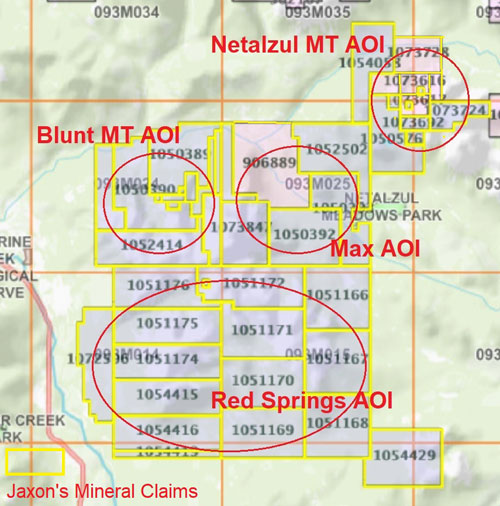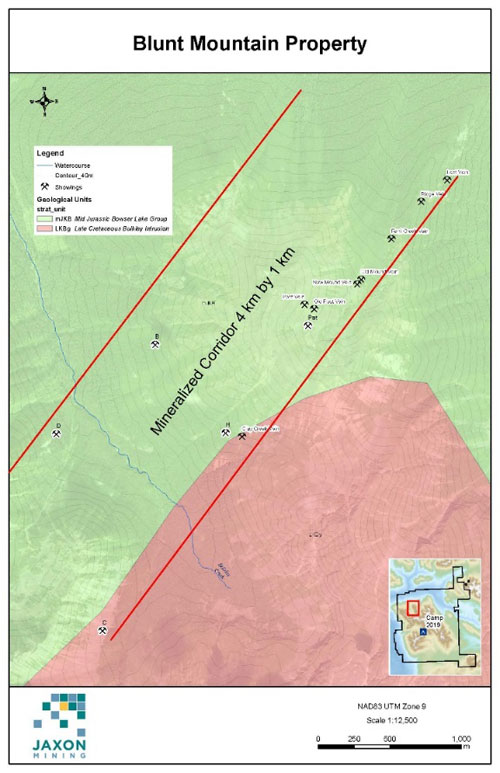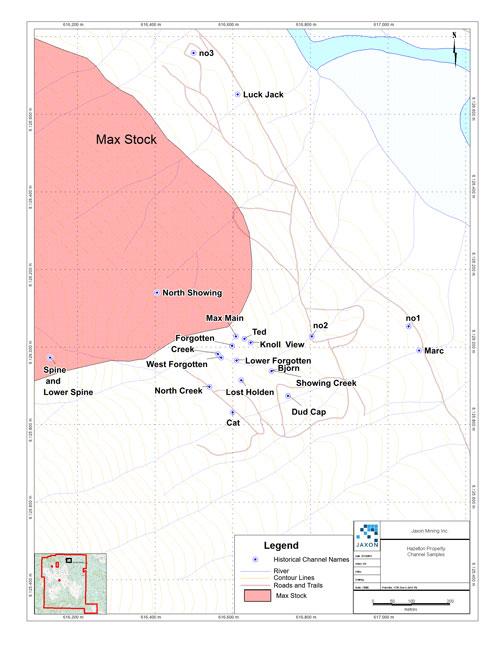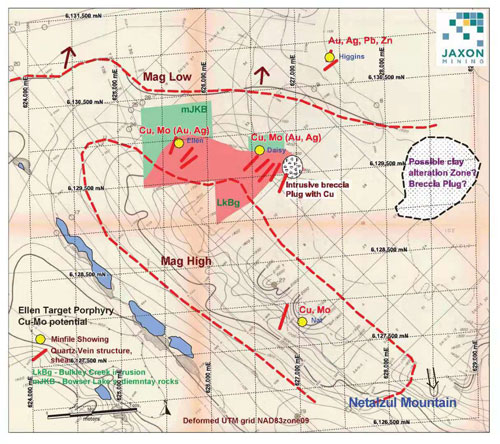January 16, 2020, Vancouver, Canada – Jaxon Mining Inc. (“Jaxon” or the “Company”) (TSX.V: JAX, FSE: OU31, OTC: JXMNF) is pleased to announce it has directly acquired or optioned nine new mineral claims to extend its Hazelton property in the Skeena Arch to approximately 463 km2 (Figure 1).
Figure 1: Jaxon’s Hazelton property map in the Skeena Arch area, near Smithers, B.C.
The new claims, 1072506, 1064626, 1073962, 1073724, 1073617, 1073617, 1073727, 1073728 and 1073729, spanning approximately 40.75 km2, have been consolidated with the Company’s existing land holdings.
Areas of Interest (AOI)
The Company has identified three areas of geologic interest, in addition to the area encompassing the Red Springs porphyry system (Figure 1).
AOI #1: The Company’s flagship project, the Red Springs copper porphyry and gold-bearing tourmaline breccia project. With 15 claims, Red Springs spans approximately 248.1 km2 and involves a large porphyry system containing three Cu porphyry targets, one > 1 km2 high grade Au-bearing tourmaline breccia zone/pipe with Co, Cu and Bi credits and two high grade polymetallic sulfide vein type mineralization. For more information on the Red Springs Project, visit www.jaxonmining.com.
AOI #2: The Blunt Mountain polymetallic project,12 claims, spans approximately 70.62 km2. Blunt Mountain is documented as a silver-lead-zinc vein or fracture-controlled mineralization hosted in Middle Jurassic to Lower Cretaceous Bowser Lake Group rocks. The clastic sediments of the Bowser Lake Group are intruded by a monzonitic to dioritic pluton of the Late Cretaceous Bulkley Intrusions. Well-developed northeast-trending sheeted joints which are mineralized by amphibole-quartz-magnetite-apatite-sulphide veins over a strike length of four kilometres and one kilometer wide, more than 12 showings have been discovered (Figure 2). Best chip sample results to date report 4.05 g/t Au over 1.2m from the Ridge Vein and 5.62 g/t Au over 1.6m from the Old Post Vein. Six diamond shallow drill holes (262 metres) were completed on the showings. Although core recovery was very poor, one hole yielded 2.4 g/t Au and 829 g/t Ag across 30 centimetres (Hole 86-1, Assessment Report 16273).
A molybdenite occurrence is also reported near an unnamed creek below the western slopes of Blunt Mountain. The showing is hosted in quartz monzonite of the Late Cretaceous Bulkley Intrusions (Map 69-1).
Figure 2: A 4 km long and 1 km wide mineralization corridor at the Blunt Mountain Polymetallic Project area
AOI #3: Max VMS project, 7 claims, spans 92.56 km2. The Max displays characteristics of the nearby Equity Silver Mine (once Canada’s most profitable silver mine) including similar age rock, shallow marine setting and possible remobilization of precious metal rich mineralization. Polymetallic sulphides with variable presence of sulphosalts were found in rhyolite and tuffs, monzonite and in marine sediments such as argillite and arenite. Variable quantities of semi-massive to massive stratiform-bedding parallel sulphides, cross cutting veins and fractures have been found in all lithologies. It is a large multiple-phase overprinting of polymetallic sulphide-sulphosalt mineralization and long-lived shallow-marine volcanogenic massive sulphide (VMS) system in the portion of the volcanic-sedimentary Rocky Ridge sequence. More than 19 historical showings have been discovered in the Max project area (Figure 3). 11 discrete intervals of high-grade silver (over 100 g/t Ag) were intercepted in seven of the 12 holes drilled in 2017. These intercepts occur as antimony-rich silver sulphosalts in polymetallic veins, feeder breccias and stratiform beds, returning grades from 103 g/t to 1,206 g/t Ag, up to 11.1% Zn and up to 2.07 g/t Au. For more information on the Max Project, visit www.jaxonmining.com.
Figure 3: Location map of historical showings at the Max project area
AOI #4: Netalzul Mountain Cu-Mo-W-Ag-Au polymetallic and porphyry project,13 claims, spans 59.12 km2. A newly consolidated project area which includes five previously acquired or optioned claims, five newly optioned claims and three newly acquired claims. It is mainly comprised of the Daisy (093M 016) and Ellen (093M 123) occurrences.
The Daisy occurrence is hosted in the contact area of a granodioritic to quartz monzonitic plug of the Late Cretaceous Bulkley Intrusions. Sample NATMR006 is described as occurring in a fracture-controlled shear zone in granodiorite with assay results greater than 1% Cu, greater than 1% Pb, greater than 100 g/t Ag and 2.26 g/t Au (Assessment Report 32043).
The Ellen occurrence is a Polymetallic veins Ag-Pb-Zn+/-Au mineralization. A 1 metre wide quartz vein cutting granodiorite with assay results of 1.0 g/t Au and 340.5 g/t Ag (Assessment Report 15186). Grab samples assay up to 2614.7 g/t Ag and 3.15 g/t Au (Assessment Report 15186).
Mineralization found at AOI #4 identify as polymetallic sulfide/quartz vein type Ag-Pb-Zn (Au) and porphyry type Mo mineralization. Sulfide veins contain pyrite, galena and tetrahedrite occurring in hornfelsed sediments and granodiorite and quartz veins contain sphalerite, galena, pyrite and chalcopyrite. The veins observed mostly occur in hornfels siltstone and granodiorite. The porphyry type Mo mineralization is hosted in the contact area of a granodioritic to quartz monzonitic plug of the Late Cretaceous Bulkley Intrusions. This porphyry type Mo mineralization occurs as disseminated and films of molybdenite in quartz veins in granodiorite. A west to east corridor trends along the contact zone of granodiorite intrusion and sedimentary rocks, where the historical air magnetic survey defines a transition zone between the magnetic high and magnetic low (Figure 4). Similar mineralization and magnetic features have been discovered at the Big Onion copper porphyry deposit 26 km southeast of Smithers, B.C.
Figure 4: Netalzul Mountain project area interpretation plan
Mr. John King Burns, CEO and Chairman of the Board commented, “These acquisitions were influenced by economics and the geological information developed through systematic exploration our team has conducted. With these additions, we now hold a largely contiguous land position. The delineation of the four separate AOIs allows us to now act as both explorationist and prospect generator. Each AOI will be offered as a joint venture to our partners for further exploration and development. The Company has taken a whole earth modeling approach and is completing a property wide conceptual geological model involving all validated historical and current geological data as it becomes available. We are fortunate to have a team of highly qualified geologists, skilled in a variety of specializations. Our team will be further augmented in the Spring of 2020 by the addition of a number of world-renowned consulting geologists as well as the exceptional team of geoscientists at MDRU. Together, this team will be designing a number of geologically informed drill targets to test our porphyry model at Red Springs during the 2020 work season.”
Roundup 2020
Jaxon will be exhibiting with HEG & Associates Exploration Services at booth 424 at the Roundup in Vancouver, January 20 to 23.
Qualified Person
Yingting (Tony) Guo, P.Geo., President and Chief Geologist for Jaxon Mining Inc., a Qualified Person as defined by National Instrument 43-101, has reviewed and prepared the scientific and technical information and verified the data supporting such scientific and technical information contained in this news release.
About Jaxon Mining Inc.
Jaxon is a precious and base metals exploration company with a regional focus on Western Canada. The Company is currently focused on advancing its Red Springs Project in north-central British Columbia.
ON BEHALF OF THE BOARD OF DIRECTORS
JAXON MINING INC.
“John King Burns”
John King Burns, Chairman




